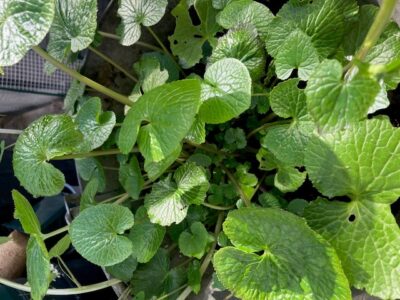
One of the plants I have kept in the greenhouse all winter is wasabi. Wasabi is native to Japan and in the wild it grows in near woodland streams, on mountains, and so at high altitude. All of this works in our favour when growing it in the UK. Japan and the UK are not so different in terms of climate, both having a proper cycle through the seasons and with plenty of wet and cold weather in winter, particularly up mountains. A Japanese winter is dryer than a UK one, but again, not next to streams. And so wasabi is a pretty easy plant to grow in the UK, is perfectly hardy, and doesn’t really need the coddling of the greenhouse. The reason it is in there is the leaves.
Wasabi is the plant behind the hugely pungent and piquant green paste that requires only a smear to flavour a whole piece of sushi. That green paste comes from the root, very finely grated. If you grow your own wasabi you can actually lift it, snap a bit off of the root, and replant it. Clean up the root and grate it and you have wasabi paste ready to go. It is really that easy. But the root is not the only part of the plant with that flavour. It is also found in the leaves. Those who love wasabi generally love the fact that it slightly clears your sinuses, but if you find it overwhelming because of that you really should try eating the leaves. They have the same flavour but are much milder and sweeter, so much so that they can be eaten raw and are delicious in a mix of salad leaves, adding an unusual taste highlight among milder and plainer leaves. If grown out of doors wasabi produces a flush of lovely soft leaves in spring, but then as summer comes on they grow larger and tougher, and can even get a bit yellowed. They are certainly not so appealing. Cut back to the ground the plant will produce a new flush of small, soft, sweet leaves in autumn, to be picked and eaten, and then the it will die back to the root at the onset of cold weather, and stay dormant all through the winter, ready to flush with green leaves again in spring.
But grown in a cold greenhouse I have found that we can extend that season of beautiful, edible, flavourful leaves from autumn right through until late spring and early summer, and we have now been picking the wasabi all thorough this winter. Admittedly this has been a particularly mild winter and in colder ones it will have a period of dormancy, but even so, the season for leaves is greatly extended.
Grow wasabi in a pot with a good drainage hole but you should also sit it in a saucer and keep it well watered, as they are very used to growing in running water. This month I will remove the pot from the greenhouse and set it is a shady spot outdoors, because if wasabi sits in direct sun the leaves will get yellowed and the plant wont grow so well, and it is not keen on hot summer conditions either. When grown commercially they are often grown in shade tunnels with their feet directly in water, so bear that in mind when caring for them and placing them in the garden. After around two years of growth, you should be able to start lifting and harvesting the roots, but in the meantime you can use your greenhouse to get a good eight months of lovely leaves from them.










